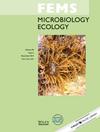有机耕作制度改善了印度椎体土壤质量,并塑造了棉花轮作中的微生物群落
IF 3.5
3区 生物学
Q2 MICROBIOLOGY
引用次数: 0
摘要
印度近 60% 的土地用于耕种,近 30% 的土壤已经退化。集约化的农业耕作方式极大地加剧了土壤退化,这凸显了采取有效对策支持可持续发展目标的迫切需要。2007 年,我们在半干旱的尼马尔山谷(印度)开展了一项长期实验,监测有机管理和常规管理对垂直土壤中植物-土壤系统的影响。我们的研究重点是评估有机和常规耕作制度如何影响土壤的生物和化学质量指标。此外,我们还跟踪了 2019 年大豆或棉花种植下整个植被期的土壤微生物群落结构。我们发现,有机耕作提高了土壤有机碳和氮含量,增加了微生物丰度和活性,并培育了与养分矿化特征相关的独特微生物群落。相比之下,常规耕作提高了参与铵氧化的细菌的丰度,这表明常规矿物肥料的硝化程度高,氮损失也随之增加。我们的研究结果强调了在亚热带半干旱地区采用有机耕作方法来改善土壤质量和减少氮损失的价值。本文章由计算机程序翻译,如有差异,请以英文原文为准。
Organic farming systems improve soil quality and shape microbial communities across a cotton-based crop rotation in an Indian Vertisol
The adverse effects of intensified cropland practices on soil quality and biodiversity become especially evident in India, where nearly 60% of land is dedicated to cultivation, and almost 30% of soil is already degraded. Intensive agricultural practice significantly contributes to soil degradation, highlighting the crucial need for effective countermeasures to support sustainable development goals. A long-term experiment, established in the semi-arid Nimar Valley (India) in 2007, monitors the effect of organic and conventional management on the plant-soil system in a Vertisol. The focus of our study was to assess how organic and conventional farming systems affect biological and chemical soil quality indicators. Additionally, we followed the community structure of the soil microbiome throughout the vegetation phase under soya or cotton cultivation in the year 2019. We found that organic farming enhanced soil organic carbon and nitrogen content, increased microbial abundance and activity, and fostered distinct microbial communities associated with traits in nutrient mineralization. In contrast, conventional farming enhanced the abundance of bacteria involved in ammonium oxidation suggesting high nitrification and subsequent nitrogen losses with regular mineral fertilization. Our findings underscore the value of adopting organic farming approaches in semi-arid subtropical regions to rectify soil quality and minimize nitrogen losses.
求助全文
通过发布文献求助,成功后即可免费获取论文全文。
去求助
来源期刊

FEMS microbiology ecology
生物-微生物学
CiteScore
7.50
自引率
2.40%
发文量
132
审稿时长
3 months
期刊介绍:
FEMS Microbiology Ecology aims to ensure efficient publication of high-quality papers that are original and provide a significant contribution to the understanding of microbial ecology. The journal contains Research Articles and MiniReviews on fundamental aspects of the ecology of microorganisms in natural soil, aquatic and atmospheric habitats, including extreme environments, and in artificial or managed environments. Research papers on pure cultures and in the areas of plant pathology and medical, food or veterinary microbiology will be published where they provide valuable generic information on microbial ecology. Papers can deal with culturable and non-culturable forms of any type of microorganism: bacteria, archaea, filamentous fungi, yeasts, protozoa, cyanobacteria, algae or viruses. In addition, the journal will publish Perspectives, Current Opinion and Controversy Articles, Commentaries and Letters to the Editor on topical issues in microbial ecology.
- Application of ecological theory to microbial ecology
- Interactions and signalling between microorganisms and with plants and animals
- Interactions between microorganisms and their physicochemical enviornment
- Microbial aspects of biogeochemical cycles and processes
- Microbial community ecology
- Phylogenetic and functional diversity of microbial communities
- Evolutionary biology of microorganisms
 求助内容:
求助内容: 应助结果提醒方式:
应助结果提醒方式:


